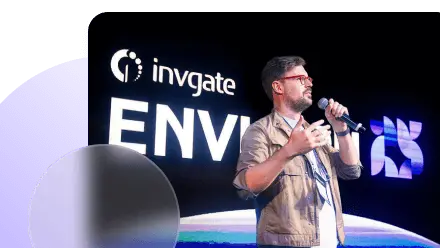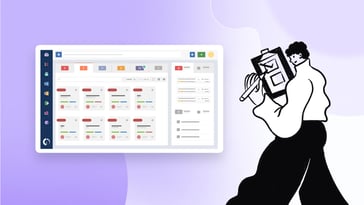Risk Management software has shifted from spreadsheets and manual tracking to systems that connect data, people, and workflows. For organizations that face increasing compliance requirements, evolving cyber threats, or complex third-party networks, the right tool can help surface risk faster and act on it with more clarity.
Whether you need support for IT risk, audits, compliance, or all of the above, the growing number of solutions means you have options. The key is understanding what kind of risk you’re managing—and how much flexibility you need.
Below are eight software options that can help organizations manage risk in different ways.
What is Risk Management software?
Risk Management software helps organizations identify, assess, monitor, and respond to risks across different areas such as IT, operations, compliance, and vendors.
These platforms usually include workflows for risk assessments, issue tracking, reporting, and regulatory compliance support. Some focus on a specific type of risk, while others offer broader integrated Risk Management (IRM) capabilities.
8 Top Risk Management software solutions for 2025
Risk management software can serve very different purposes depending on the context—some tools are built for audit teams, others for IT, compliance, or vendor oversight. This list includes a mix of options designed to support a range of needs, from specialized functions to broader integrated risk programs.
1. InvGate Asset Management

Risk Management tools help businesses identify, assess, and reduce potential risks related to operations, compliance, or cybersecurity. Platforms specifically designed for this exist, but many organizations start by adapting tools they already use.
InvGate Asset Management, for example, is an ITAM solution that can help address risk at the infrastructure level. It isn't a dedicated IT Risk Management platform; however, it can support risk-related workflows by centralizing data, automating responses, and improving visibility across your IT assets. Depending on the complexity of your risk program, that might be enough — or a practical foundation before adopting something more specialized.
InvGate Asset Management features
- Inventory Management: Build a complete IT asset inventory in under 24 hours. With multiple discovery methods, you’ll always know what you have and where it’s located.
- Risk Management automation: Set custom asset Health Rules to detect and respond to issues before they escalate. Automated alerts enable faster reactions and more proactive risk mitigation.
- Risk and impact analysis with AI: Predictive tools assess the risk and impact of change requests based on historical patterns. This helps teams avoid underestimating issues and supports business continuity.
- CMDB (Configuration Management Database): Map relationships between assets, services, and users. This visibility supports better decision-making and helps assess operational risks.
- Advanced reporting: Analyze trends, identify vulnerabilities, and prepare for audits using customizable dashboards and reporting tools.
- Integrations: Connect with identity management tools, directories, and InvGate Service Management to align risk and IT operations.
InvGate Asset Management pricing details
InvGate Asset Management offers scalable pricing based on the number of nodes you need to manage.
The plans are:
- Starter Plan: Covers up to 500 nodes at $0.21 per node per month ($1,250 billed annually).
- Pro Plan: Supports 501-10,000 nodes at $0.38 per node per month (billed annually).
- Enterprise Plan: Tailored for large enterprises with custom node requirements. Contact sales for pricing.
Unsure which plan suits you? Start with a 30-day free trial (no credit card required)
InvGate Asset Management user reviews and ratings
InvGate Asset Management holds a 4.5/5 score on Gartner Peer Insights. Users appreciate its ease of use and powerful automation, especially in environments with many endpoints. Reviews highlight the tool’s flexibility for custom workflows.
“My Overall experience with InvGate Asset Management is Awesome. It's maintenance scheduling feature has reduced downtime, we can easily schedule in advance. It's user interface is good intuitive and easy to use, It's implementation process is smooth. I can easily share the data between the systems; It has seamless integration with our ERP system.”
User review from Gartner, Manager - Facilities
2– Splunk
Splunk is a data platform developed by Cisco Systems that is often used for security and observability. It's known for helping organizations detect anomalies and respond to incidents in real-time. Splunk can be deployed on-premise, in the cloud, or a hybrid setup.
Splunk features
- Real-time monitoring and analytics.
- Security Information and Event Management (SIEM).
- Machine learning for anomaly detection.
- Integration with a wide range of data sources.
Splunk pros and cons
Pros:
- Strong for security risk detection.
- Highly customizable.
- Scalable for enterprise use.
Cons:
- Steeper learning curve.
- Cost can increase quickly with scale.
Splunk pricing details
Splunk uses a usage-based pricing model, which depends on data ingestion volume. Pricing details are available on request.
Splunk user reviews and ratings
Splunk hold a 4.4 score in Gartner. Reviews are generally positive, particularly for its powerful search and monitoring capabilities. Users note its complexity but value its flexibility.
"Overall, Splunk Enterprise is an amazing platform with many great features that makes it a compelling value proposition, despite its high costs. It is one of the best platforms for analyzing machine data for operational intelligence, business analytics, and security monitoring. Potentially very expensive - Anyone with Splunk experience knows that managing costs can be a challenge, especially for those large quantities of data that need to be processed."
User review from Gartner, Engineer - IT Services

3- Archer
Developed by RSA, Archer is an integrated Risk Management platform often used by enterprises for governance, risk, and compliance (GRC) initiatives. It helps organizations centralize data, automate processes, and gain insight into risks across departments.
Archer features
- Risk register: Maintain a centralized view of known risks, including ownership, impact, and mitigation plans.
- Third-party Risk Management: Assess and monitor vendor risks through built-in questionnaires and workflows.
- Audit Management: Track audit findings and link them to associated risks and controls.
- Policy Management: Distribute policies, track acknowledgments, and ensure version control.
Archer pros and cons
Pros:
- Highly configurable for complex enterprise needs.
- Extensive GRC coverage in a single platform.
- Strong audit trail and reporting capabilities.
Cons:
- Steep learning curve.
- May require dedicated admin resources for ongoing maintenance.
Archer pricing details
Pricing is not publicly available. It typically varies depending on the number of modules, users, and deployment scale.
Archer user reviews and ratings
Users generally rate Archer positively for its depth and flexibility, particularly in large organizations. However, some reviews mention challenges with usability. On Gartner, it averages around 4.2 out of 5 stars.
"Archer is a modular risk management tool that allows granular levels of customization to fit in huge number of use cases. Although the tool is very much relevant in today's time due to its various capabilities including integrations with various security tools, the UI looks outdated making the tool look dated.”
User review from Gartner, Deputy Manager - Banking
4- MetricStream
MetricStream is a cloud-based GRC solution designed for large enterprises looking to manage regulatory compliance, operational risk, and internal audits. It offers modular tools that can be tailored to specific Risk Management needs.
MetricStream features
- Enterprise Risk Management: Track and mitigate enterprise-wide risks in a structured way.
- Regulatory compliance: Stay aligned with changing regulations using real-time monitoring and content libraries.
- Operational risk tools: Conduct risk assessments, define controls, and automate mitigation tasks.
- Internal audit support: Coordinate audit lifecycles with planning, execution, and follow-ups.
MetricStream pros and cons
Pros:
- Deep functionality for compliance-heavy environments.
- Scalable architecture with modular apps.
- Good automation for workflows and alerts.
Cons:
- Can be expensive for mid-sized companies.
- Implementation and customization can take time.
MetricStream pricing details
Pricing is quote-based and tailored to your use case, number of users, and modules required.
MetricStream user reviews and ratings
Users appreciate the breadth of GRC capabilities, especially for risk documentation and compliance tracking. Some feedback points to usability issues and a steep implementation curve. It’s rated 4.0 stars on Gartner.
"MetricStream has made a perfect platform for handling risk data. The centralized view and the less number of reports are the benefits of such a system. However, now and then, there are some issues arising in terms of data integration, which may affect the ultimate capability of the platform."
User review from Gartner, Senior Manager - Retail
5- LogicGate Risk Cloud
LogicGate Risk Cloud is a flexible platform for automating risk and compliance workflows. It’s especially popular with mid-market and enterprise teams that want more control over how risk processes are built and scaled.
LogicGate Risk Cloud features
- No-code workflow builder: Create risk processes without relying on developers.
- Third-party Risk Management: Manage vendor assessments and remediation efforts.
- Control testing and monitoring: Schedule and automate control reviews with notifications.
- Incident Management: Track issues from detection to resolution with full audit trails.
LogicGate pros and cons
Pros:
- Highly customizable workflows
- Intuitive interface for non-technical users
- Strong customer support
Cons:
- Requires some process design work up front
- Limited offline functionality
LogicGate pricing details
Pricing is custom and depends on the apps selected and scale of deployment. Some users note that it becomes more cost-effective at higher volumes.
LogicGate user reviews and ratings
Often praised for ease of use and customization. Many users like that they can quickly adjust processes as their risk program evolves. It scores 4.6 stars on Gartner Peer Reviews.
"Logicgate is a promising product that we purchased to replace our previous GRC vendor. I most like the ease of setting up and customizing applications and their risk analysis functionality, which uses FAIR. Dislikes: Time to deploy, confusion on what modules were included."
User review from Gartner, Sr Security Risk Assessor - IT Security
6- Riskonnect
Riskonnect is a cloud-based integrated Risk Management tool designed to connect risk data across departments. It’s used for enterprise risk, claims management, and compliance, especially in industries like healthcare and manufacturing.
Riskonnect features
- ERM dashboards: Monitor and prioritize risks using real-time dashboards.
- Incident and claims tracking: Manage incidents, claims, and related costs in one system.
- Compliance tracking: Stay current with regulatory requirements across business units.
- Risk appetite and tolerance mapping: Define and monitor thresholds to guide risk-based decisions.
Riskonnect pros and cons
Pros:
- Purpose-built for highly regulated industries.
- Connects risk, compliance, and claims data.
- Good data visualization tools.
Cons:
- Some users mention a dated interface.
- Requires ongoing configuration for best results.
Riskonnect pricing details
Custom pricing based on organization size, modules, and industry use case. Demo and quotes are available on request.
Riskonnect user reviews and ratings
Generally reviewed as robust and practical for organizations needing detailed reporting. Some feedback suggests UI improvements could enhance the experience. It has a 4.1 rating on Gartner Peer Reviews.
"Its easy to implement product and its consider the technology,people, overall risk and management. The basic integration is easy.our risk reduced and security improved. "
User review from Gartner, Software engineer

7- OneTrust
OneTrust started with privacy and compliance tools but has expanded into broader risk and trust management. It offers solutions for IT risk, third-party risk, ESG, and ethics—making it suitable for organizations with diverse compliance needs.
OneTrust features
- IT and Cyber Risk Management: Conduct assessments and manage remediation workflows.
- Third-party risk tools: Automate due diligence, onboarding, and monitoring of vendors.
- Privacy compliance: Built-in templates and tracking for GDPR, CCPA, and more.
- Policy and ethics programs: Manage codes of conduct, training, and disclosures.
OneTrust pros and cons
Pros:
- Strong in privacy and regulatory compliance
- Frequent updates to meet changing laws
- Scales well across business functions
Cons:
- Can feel overwhelming due to the breadth of features
- Pricing may increase quickly as needs grow
OneTrust pricing details
Pricing is subscription-based and varies widely depending on use cases and the number of modules licensed.
OneTrust user reviews and ratings
Users generally view OneTrust as comprehensive and up-to-date with regulatory trends. Some mention a learning curve during implementation. It has a 4.1 score in Gartner.
"OneTrust Tech Risk & Compliance is a great tool with a high potential but the inability to personalize it as much as needed is disappointing. The centralized dashboard is a big plus, but the challenge comes in trying to customize the dashboard for our particular environment."
User review from Gartner, Network Engineer
8- AuditBoard
AuditBoard started as an audit and SOX compliance platform and has evolved into a broader risk and compliance solution. It’s best suited for internal audit teams, finance, and compliance leaders.
AuditBoard features
- Risk Management: Identify and monitor key risks with visual heatmaps and custom scoring.
- Audit Management: Plan, execute, and report on audits in a single workspace.
- SOX compliance: Purpose-built tools for control testing, documentation, and tracking.
- Policy Management: Centralize and distribute corporate policies.
AuditBoard pros and cons
Pros:
- Easy to use for auditors and finance teams.
- Strong SOX support.
- Clear audit trails and evidence documentation.
Cons:
- Less flexible for use cases outside audit and financial risk.
- May not cover all enterprise IRM needs.
AuditBoard pricing details
Pricing is quote-based and typically scales with the number of modules and users.
AuditBoard user reviews and ratings
Frequently praised for ease of use and time savings in audit workflows. It hold a 4.5 score on Gartner Peer Insights.
“The platform is highly customizable, so it can be implemented to meets the needs of your program. It's a great tool for team collaboration. It makes stakeholders an integral part of the process. If you're program is not already developed and mature it can be difficult to setup, but the implementation team was both patient and knowledgeable to get us where we needed to be."
User review from Gartner, Administrator - Information risk and compliance
How to choose the right Risk Management platform?
Before looking at products, clarify what kind of risk you're trying to manage. Technical risk, vendor oversight, internal control frameworks, and policy compliance require different features, workflows, and levels of customization. A financial institution dealing with model risk has very different needs from an IT team tracking patch compliance.
Start by listing your risk categories, the frequency and complexity of assessments, who owns the response, and how reporting is handled. These factors will help shape your requirements.
Some teams need structured, ready-made workflows. Others require the flexibility to configure their own assessments and scoring models. Some tools are better suited for organizations with formal governance models, while others are built for speed and adaptability.
Once you have a clear picture of your needs, focus on evaluating core features:
- Customizable risk registers and scoring frameworks
- Automated workflows for assessments and reviews
- Audit and control testing modules
- Policy Management and documentation tools
- Support for third-party or vendor risk
- Compliance mapping for standards like SOX, ISO, GDPR, or HIPAA
- Dashboards for reporting risk levels and trends to stakeholders
It's also important to consider how the platform fits with existing systems and teams. Look at how easily it integrates with tools used for Service Management, identity and access control, or business continuity planning.
Conclusion
Choosing a Risk Management platform depends on your organization’s structure, how you define and assess risk, and the level of coordination required across departments. A solution built for IT teams won’t always meet the needs of audit or legal—and vice versa. The more clearly you can map your processes, users, and regulatory context, the easier it becomes to identify the right fit.
Software should support — not reshape — how your teams work. Look for something that complements your priorities and scales with them. Risk isn’t static, and your platform shouldn’t be either.















